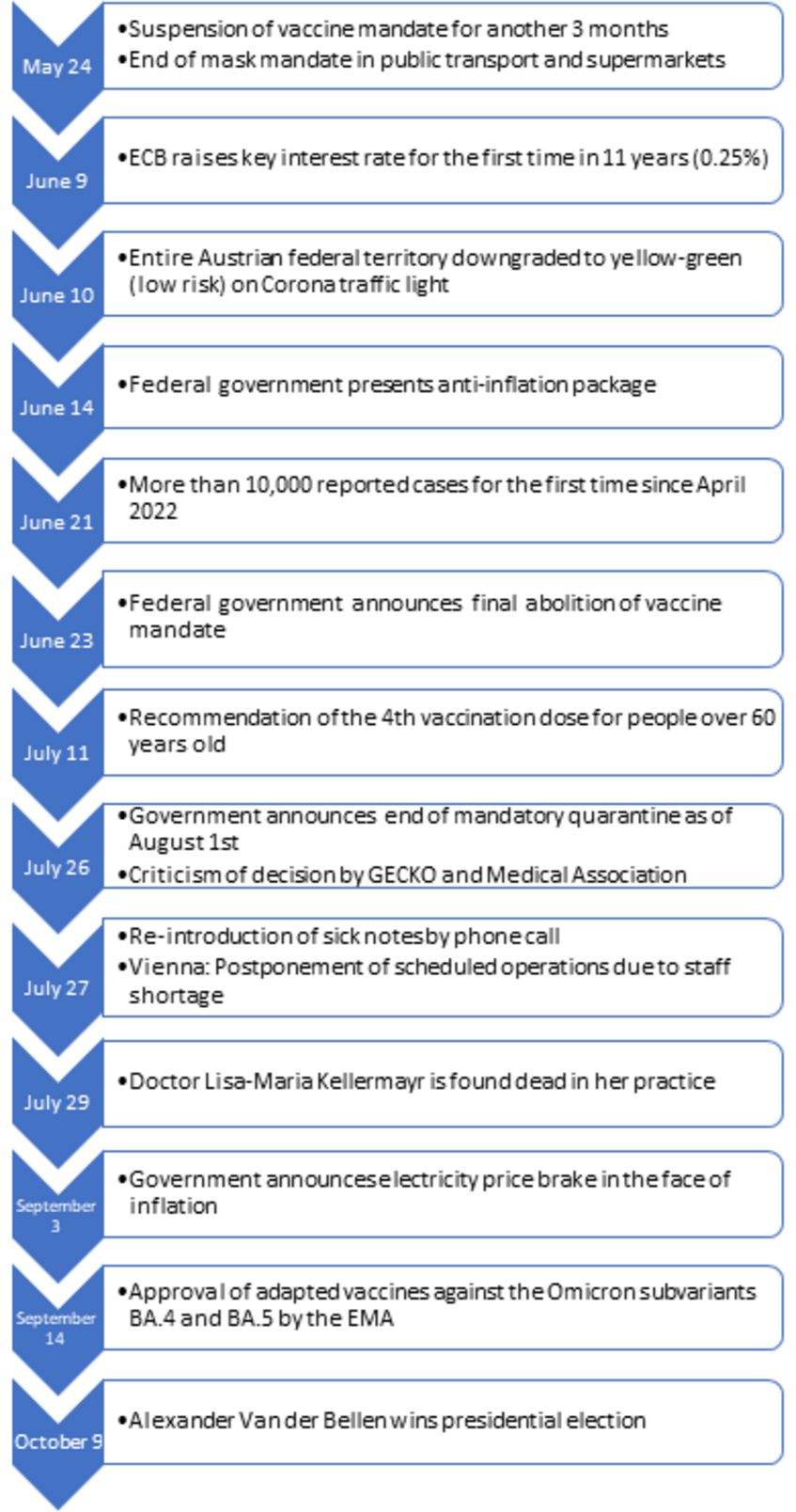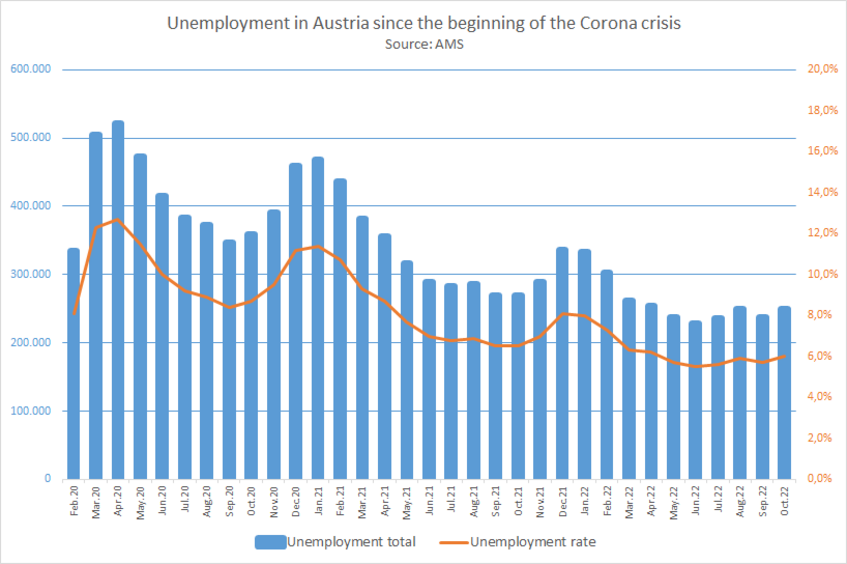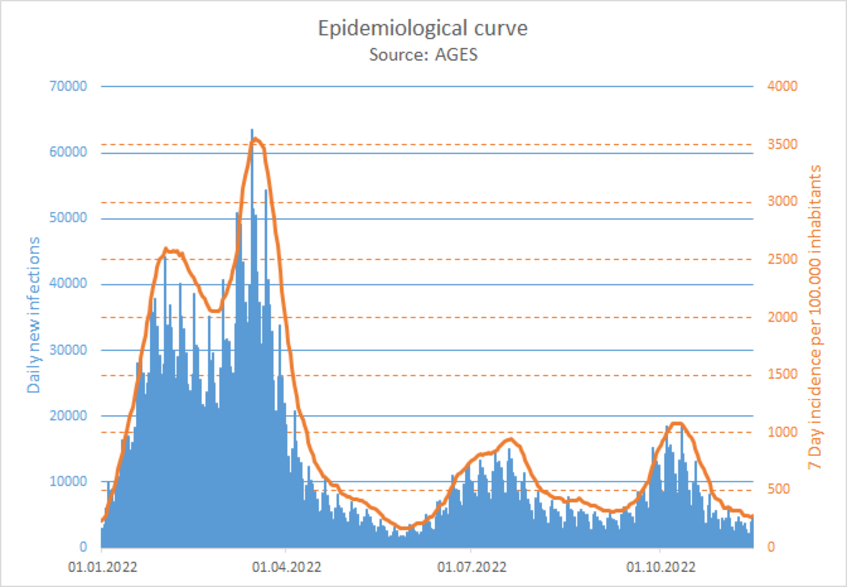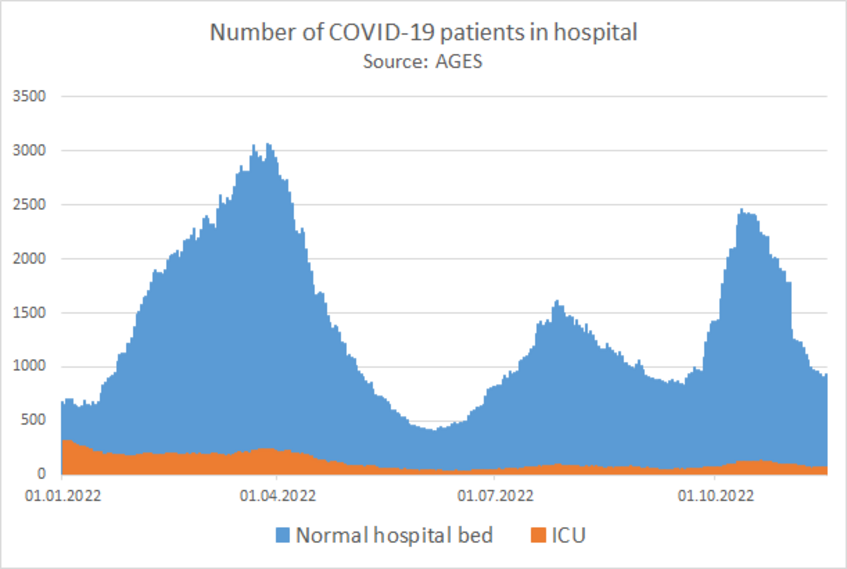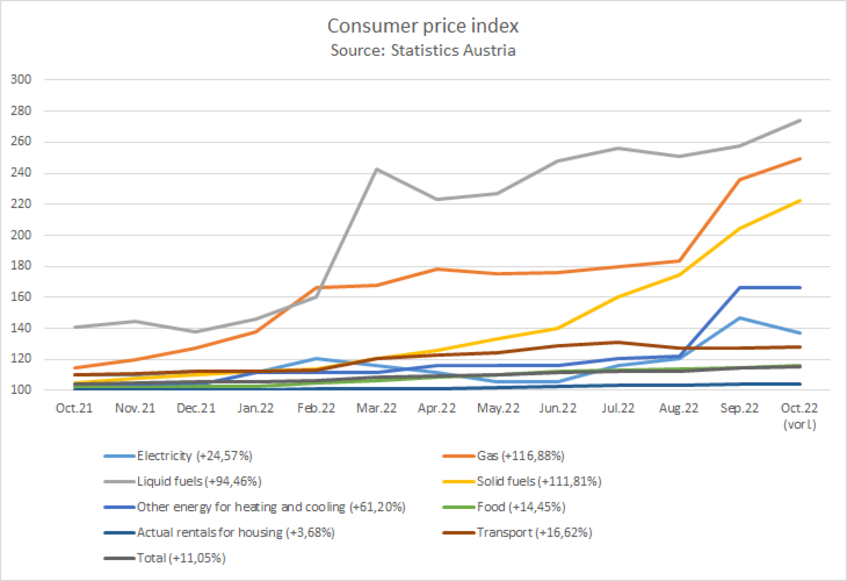05.01.2023 - PDF
Chronology on the Corona Crisis in Austria - Part 8: The end of the vaccine mandate, a summer wave, the death of Dr. Lisa-Maria Kellermayr, new crises and new vaccines
- In the course of 2022, many COVID-19 measures were withdrawn. For example, in June 2022, the mask mandate ended in supermarkets and in public transport throughout Austria (exception: Vienna). In addition, the already suspended COVID-19 vaccine mandate was officially abolished by a parliamentary resolution in July 2022. In addition, compulsory segregation of COVID-19 infected individuals has been dropped and a so-called „traffic restriction“ took its place from August 2022 onward.
- Since June 2022, the infection figures have again risen significantly, despite lower testing rates. In contrast to previous years, a summer wave built up for the first time. The official infection figures at the time fell short of various predictions. However, this may include a high number of unreported cases due to falling testing rates. At the end of July 2022, Dr. Lisa-Maria Kellermayr took her life after receiving death threats from COVID sceptics. Discussions about the lack of support by the authorities followed.
- In 2022, several new crises and issues emerged – in particular the Ukraine war, the energy crisis and the associated inflation, but also the spread of monkeypox. As a result, the COVID-19 issue increasingly disappeared from public awareness and the focus of political action.
- A new booster vaccination campaign began in autumn 2022, with a new vaccine adapted to the BA.4/BA.5 virus variant being available in October 2022. Nevertheless, in view of a growing pandemic fatigue and multiple new crises, booster vaccination progressed only at a moderate pace.
By Christina Walcherberger, Florian Holl, Markus Pollak and Julia Partheymüller
This article documents the key events, developments and measures of the COVID-19 crisis in Austria in the period from May to October 2022. Seven previous articles on the chronology of the Corona crisis in Austria have already described the first lockdown in spring 2020, the subsequent phase of normalisation in summer 2020 and the beginning of the second wave in autumn 2020. Furthermore, the lockdown in winter 2020/21 and the third wave in spring 2021 have already been outlined in earlier articles. Lastly, we looked at the spread of the "delta" variant in autumn 2021 as well as the subsequent delta-related lockdown, the wave gaining momentum in winter/spring 2022 and finally the "spring awakening" and further easing of measures until April 2022. In this article, we describe what has happened since then.
May 2022 - June 2022: The withdrawal of many measures and the start of the summer
After the national vaccine mandate was initially suspended for 3 months on the 9th of March 2022, as reported in the last part of the chronology, the federal government announced, on the 24th of May, that it would continue to not enter into force in view of the milder courses of the Omicron variant. In addition, the end of the mask mandate in supermarkets and public transport, with the exception of Vienna, was announced at the federal level, as well as the waiving of compulsory PCR tests in schools starting on the 1st of June. This was justified with the declining numbers of positive COVD-19 tests. Shortly afterwards, however, on the 30th of May 2022, the Ministry of Health announced that it expected the mask mandate to return in autumn at the latest. On the 31st of May 2022, the Italian government announced that starting on the 1st of June, 3G proof will no longer be required to enter Italy. Almost simultaneously, the first suspected and later confirmed case of monkeypox was identified in Austria on the 22nd of May 2022. Starting on the 24th of May 2022, reporting monkeypox infections was mandated.
Due to rising prices, the government discussed possible relief measures on the 4th of June 2022. A bit later, on the 14th of June 2022, it presented a legislative package against the ongoing inflation. On the 9th of June 2022, the European Central Bank (ECB) raised the key interest rate from 0 to 0.25 percent for the first time in eleven years due to high inflation. While high inflation caused economic problems, unemployment continued to decrease (see Figure 2).
On the 3rd of June 2022, the Austrian Court of Audit expressed criticism of the government's pandemic management. For example, it concluded that the cooperation between the federal government and the states, but also among the federal authorities, had often been uncoordinated. On the 10th of June 2022, the entire Austrian federal territory was downgraded to yellow-green (low COVID-19 risk) on the Corona traffic light.
During the month of June, an emerging summer wave of infections intensified. Around the 18th of June 2022, the number of daily reported infections was at about 4,700. Experts expressed their concern accordingly. On the 21st of June, for the first time since April 2022, there were more than 10,000 reported new infections (10,995 - see Figure 3). Two days later, the Minister of Health, Johannes Rauch (Greens), and the parliamentary group chairman of the Austrian People's Party (ÖVP), August Wöginger, finally announced the complete abolition of the vaccine mandate, which had previously only been suspended.
In view of the rising number of infections, there were staff shortages in various areas, similar to the first Omicron wave in spring 2022. On the 27th of June 2022, the Austrian Airlines (AUA) reported many cancelled flights due to a high incidence of COVID-19 infections among staff members. The following day, the Austrian National Vaccination Board officially recommended the fourth vaccine dose for people older than 65 years. At the same time all of Austria was assessed as yellow [medium risk] on the Corona traffic light, with the exception of Vienna and Burgenland, which were classified as orange (high risk).
July 2022: The end of the vaccine mandate and quarantine
On the 4th of July 2022, it became public that after Hygiene Austria had been involved in a scandal concerning the re-labelling of masks produced in China, an out-of-court settlement had been reached. About 500 plaintiffs had joined forces and were to be compensated with about 70 euros per person.
On the same day, the Vienna Medical Association demanded, due to the deteriorating staff situation, that the City of Vienna should create a plan of measures in case of a system overload. Shortly afterwards, on the 7th of July 2022, the Mayor of Vienna, Michael Ludwig, announced a mask mandate for health workers in Vienna and that the number of visitors to hospitals would be limited to a maximum of three tested visitors per day and patient. After the government had already announced the official abolition of the vaccine mandate, the Parliament decided to put a definitive end to it.
On the 11th of July 2022, the European Centre for Disease Control (ECDC) and the European Medicines Agency (EMA) recommended a fourth vaccine dose for all people over 60, due to the decreasing protective effect after the third dose. A few days later, on the 19th of July 2022, the COVID prognosis consortium, consisting of experts from the Vienna University of Technology, the Medical University of Vienna and the Austrian National Public Health Institute, published one of its weekly forecasts calling for a change in strategy in the fight against the pandemic. Due to a change in testing behaviour and different testing offers, the infection figures would no longer reliably reflect the spread of the virus. The focus should therefore be on hospital figures (intensive care units (ICU) and normal hospital bed occupancy), as these would only be distorted to a small extent by behavioural effects, such as changing testing behaviour.
In addition, draft legislation to end the required quarantine became public on that day. This was immediately met with criticism, among others from the Mayor of Vienna, Michael Ludwig. The bill was preceded by a lengthy discussion on required quarantine. The states with social democratic government in particular were critical. In view of the high number of infections, they argued that it would be necessary to prepare for autumn and winter. In addition, the end of the required quarantine would raise unresolved questions of labour law and liability in the workplace. The unclear legal situation was also criticised, because it was not initially clarified whether state governors themselves are allowed to decide on quarantine measures in their state. The Ministry of Health, however, emphasised the usually milder course of the predominant Omicron virus variant. It is not expected that the health infrastructure will be overloaded if the required quarantine is abolished. In addition, the introduction of so-called “traffic restrictions” that allow people to visit the workplace instead of strict quarantine could ensure staff availability in critical infrastructure. The evidence base of these arguments remained controversial and members of the GECKO expert commission reportedly rejected responsibility for this political decision.
Despite ongoing criticism, the government consulted with the state governors on this plan on the 25th of July 2022. On the next day, the government announced that it had decided to end required quarantine and that from the 1st of August 2022 onwards only a so-called "traffic restriction" would apply to people infected with COVID-19. People infected with COVID-19 were to be allowed to leave their home, but were subject to certain mobility restrictions. The “traffic restrictions” included a FFP2 mask mandate outside the private living area and when in contact with other people, as well as a ban on entering facilities with vulnerable groups or high-risk locations such as care facilities. On the 27th of July 2022, it was then announced that sick notes by phone call would be reintroduced due to the end of the quarantine requirement. On the same day, Vienna became the first province to announce that scheduled operations were, once more, to be postponed due to staff shortages caused by illness. Vienna announced that it would maintain stricter measures compared to the rest of the federal states, as it had done many times before during the pandemic. No employees who tested positive would be allowed to work in hospitals, kindergartens and schools.
On the 29th of July 2022, doctor Lisa-Maria Kellermayr was found dead in her office in Upper Austria. During the pandemic, she had been massively threatened by opponents of government measures and vaccination. The public prosecutor's office in Wels confirmed that it was a suicide. A post-mortem examination also found no evidence of external influence. The threats were triggered by a tweet from Kellermayr about a protest by opponents of the COVID-19 measures in front of the Wels-Grieskirchen hospital, which the Upper Austria police had described as a false report via Twitter. The death threats she received as well as the very high expenses for security measures were reasons for her to close her practice at the end of June 2022. The investigations into the origin of the threats were unsuccessful for a long time. It was only when a "hacktivist" from Germany took up the cause that a suspect in Germany could be identified, raising the question of which jurisdiction would be responsible for the case. The death of Dr. Lisa-Maria Kellermayr has been a shock for many, even beyond the borders of Austria. Numerous obituaries commemorated her tireless efforts as a medical doctor during the pandemic. On the 1st of August 2022, a vigil was held at Stephansplatz in Vienna with thousands of participants to commemorate her.
August 2022 - September 2022: New vaccines, inflation and rising case numbers
Furthermore, on the 1st of August 2022, the regulation abolishing required quarantine came into force. Due to the continuing high numbers of infections and the resulting shortage of staff, Lower Austria also employed staff who had tested positive for COVID-19 in hospitals at that time, but only if they were symptom-free and not working in particularly sensitive areas. On the 7th of August 2022, about a month before the start of school, it was reported that the number of school deregistrations, which had risen sharply during the pandemic, had declined significantly for the coming school year. The following day, Biontech/Pfizer announced its intention to launch two vaccines adapted to the current Omicron virus variant in autumn.
On the 9th of August 2022, the Minister of Education, Martin Polaschek (ÖVP), announced that teachers who had tested positive and were symptom-free would be allowed to teach if they wore masks. This announcement was immediately strongly criticised. On the same day, the city government of Vienna announced that no teachers who had tested positive would be allowed to teach. Burgenland followed Vienna's example. Moreover, on the 9th of August 2022, a preliminary report by the Austrian Court of Audit was published, in which it once again criticised the government's pandemic management and the COVID-19 financing agency of the federal government, COFAG. The Court specifically criticised the duplication of posts, double salaries and high expenses for consultations. The city of Vienna announced on the 26th of August, that the mask mandate in public transport, which was lifted in all other provinces in June 2022, would be extended until at least the end of October 2022. A little later, Education Minister Polaschek (ÖVP) confirmed that the upcoming school year would start without compulsory testing and a mask mandate.
On the 11th of August 2022, experts, such as complexity researcher Peter Klimek, spoke out and criticised that the reported infection figures in Austria were hardly meaningful due to the low COVID-19 test figures. The infection figures could be two to three times higher than officially reported and the number of unreported cases accordingly very high. Forecast models for autumn and winter are therefore extremely difficult to calculate. The Ministry of Health reported the next day that a total of 19 million COVID-19 vaccinations had been administered and 50,000 reports of side effects were received. 1,400 applications for compensation under the Vaccine Damage Act had been filed and 7 of them were approved. Those affected were compensated with an average of around 1,600 euros.
On the 23rd of August 2022, it was announced that the inactivated vaccine Valneva could be partially vaccinated in Austria as early as the end of August 2022. Unlike mRNA vaccines, which stimulate the body to produce harmless copies of the COVID-19 spike protein itself, inactivated vaccines like Valneva administer killed virus particles as part of the vaccination. Vienna started using Valneva on the 1st of September 2022, with other states following shortly afterwards. As the vaccine was only offered as a first vaccine dose and vaccine hesitancy among those who had not been vaccinated by that time was high, demand was rather low. At the end of August, the National Vaccination Committee updated its recommendation: all people over 12 were recommended a booster vaccine dose (fourth vaccine dose) for the autumn. At that time, however, a significant number of people were ready to be vaccinated and wanted to wait for the Omicron-adapted vaccines, in accordance with the advice of some experts.
On the 26th of August 2022, Eurostat, the statistical office of the European Union, published statistics on the aid payments distributed during the pandemic. According to Eurostat, Austria spent the biggest amount per capita on Corona aid in a EU comparison - namely an average of 1,475 euros per person.
At the same time the energy crisis worsened due to the Russian war of aggression on Ukraine, prompting Constitutional Minister Karoline Edstadler (ÖVP) to call for "common sense" and "personal responsibility" in dealing with electricity and gas at the beginning of August 2022. However, as energy prices continued to rise, the government agreed on an electricity price cap on the 3rd of September 2022. This was to ensure that 80 per cent of the average household consumption of electricity would be offered at cheaper rates through state subsidies. The measure was intended to mitigate the expected high price increases in the energy sector, which were an important factor in inflation. A few days later, on the 7th of September 2022, the electricity price cap was adopted by the Council of Ministers. The next day, the European Central Bank (ECB) raised the key interest rate again, this time by 0.75 percentage points to 1.25 per cent. On the 11th of September, Environment Minister Leonore Gewessler (Greens) announced that, in view of the energy crisis, a maximum temperature of 19 degrees was to be introduced in public buildings such as ministries or offices (but not, for example, in schools and hospitals). Bans on radiant heaters and advertising lighting after 10 p.m. were also considered. The following day, the government presented a campaign with tips on how to save energy in the household.
According to Statistics Austria, the inflation rate in September 2022 was around 10.5 per cent. This value represented the highest inflation since July 1952. On the 27th of September 2022, it was reported that the country's universities will face serious financial distress due to inflation as well. For the years 2022, 2023 and 2024, they would need a much higher budget (1.2 billion euros more). The university conference warned that otherwise temporary contracts could not be extended. In this context, lower room temperatures or even partial closures of buildings were considered.
Figure 5: Consumer price index according to COICOP (Classification of Individual Consumption by Purpose) for electricity, gas, liquid fuels, solid fuels, other energy for heating and cooling, food, actual rentals for housing, transport and total (source: Statistics Austria). Percentages refer to the relative change compared to the previous year (own calculation based on data from Statistics Austria)
After the National Vaccination Panel had now also recommended the fourth vaccine dose for all people older than 12 at the end of August, the European Medicines Agency (EMA) recommended the approval of the vaccines from Moderna and BioNTech/Pfizer adapted to the BA.1 Omicron variant the next day. Shortly afterwards, on the 9th of September, the first vaccine adapted to the BA.1 Omicron variant arrived in Austria from BioNTech/Pfizer. In addition, on the same day, an online pre-booking system for the monkeypox vaccination came into effect in Vienna. Soon after, a COVID vaccine adapted to the Omicron variants BA.4 and BA.5 was approved by the European Medicines Agency EMA on the 14th of September.
On the 13th of September 2022, the World Health Organization (WHO) published figures on Long COVID. Thus, between 2020 and 2021, at least 17 million people in Europe suffered from symptoms of Long COVID.
On the 27th of September 2022, newspapers reported that the Vienna Public Prosecutor's Office investigated the FPÖ member of parliament Christian Hafenecker for an offence of data falsification. The case concerned the alleged incitement to falsify COVID-19 test certificates. The investigation was started due to chat messages on the mobile phone of a former employee. Meanwhile, the COVID-19 infection numbers continued to rise. For example, the day before, there were 15,317 new infections, with an average of 8,976 new infections per day over the last few days.
On the 30th of September 2022, Ukrainian President Selensky officially applied for accelerated NATO accession after Russian President Putin had previously held mock votes and, following these, declared four occupied territories of Ukraine to be Russian territory.
October 2022: Further increase in the number of cases, high number of unreported cases and still no mask mandate
On the 3rd of October 2022, the City of Vienna activated 1,200 additional monkeypox vaccination appointments due to high demand. However, they were still only available for risk groups.
Due to rising infection figures, all states were assessed as either yellow [medium risk] (Vorarlberg, Tyrol, Carinthia, Upper Austria, Lower Austria) or orange [high risk] (Salzburg, Styria, Burgenland, Vienna) on the Corona traffic light as of the 6th of October 2022. On the same day, GECKO recommended wearing FFP2 masks, for example in public transport and indoors.
The Austrian Presidential Election took place on the 9th of October 2022. That same evening it was already confirmed that the incumbent president Alexander van der Bellen had been re-elected with 56.7% percent in the first round of voting.
After a discussion about reintroducing the mask mandate in certain areas, the Ministry of Health announced, on the 19th of October, that it would not be extended for the time being. The mask mandate would continue to apply only in particularly vulnerable locations such as hospitals. However, this could change, depending on the pandemic situation. In a report that was published on the 19th of October, GECKO showed that wastewater analyses would indicate a high number of unreported COVID-19 cases. GECKO warned that the number of new infections per day could be three times higher than the number of reported positive tests. Accordingly, GECKO still recommends wearing FFP2 masks in crowded indoor spaces or public transport .
On the 20th of October, the European Medicines Agency (EMA) approved COVID-19 vaccination for infants older than six months. Previously, Corona vaccination had only been approved for children older than 5 years. Each country could decide for itself whether the vaccination should be offered to babies and toddlers.
One day later, the Ministry of Education announced that the special COVID-19 regulations concerning the AHS1 A-levels (“Matura”), which had been in force until then and were supposed to mitigate negative effects of the pandemic on students, would expire for the future exams. The additional hour of work for written examinations, the alternative dates in the event of being unable to attend and the possible reduction of subject areas in the oral exam would therefore be discontinued.
On the 28th of October 2022, experts once again spoke out and warned about heavy infection waves in autumn/winter. They argued that the warm late autumn had caused the number of new COVID-19 infections to fall, but the new Omicron virus variants BQ.1 and BQ.1.1 would become increasingly important in Austria. In addition, these variants could bypass the body's immune defences even better. The European Centre for Disease Prevention and Control (ECDC) also expected another wave of COVID infections carried by these virus variants for the period from mid-November to January.
Summary and conclusion
Between May and November 2022, the pandemic increasingly disappeared from public perception due to new emerging crises. The federal government eased a number of measures, lifted the mask mandate and required quarantine and declared the end of the controversially discussed COVID-19 vaccine mandate. There was thus a paradigm shift towards the individualisation of health risks posed by the Coronavirus and the responsibility for protective measures. The summer wave was largely no longer mitigated by protective measures. Moreover, the tragic death of Dr. Lisa-Maria Kellermayr occurred.
In autumn 2022, new vaccines adapted to the Omicron variant were used for the first time. However, the new vaccines and the campaign for booster vaccinations received little attention from the population and vaccination numbers progressed only at a moderate pace. With the ongoing Russian war of aggression on Ukraine and the related inflation and energy crisis, other issues dominated the political agenda. The COVID-19 theme faded into the background.
At the same time, however, infection numbers remain high. Due to falling testing numbers and the resulting higher number of unreported cases, it became increasingly difficult in this phase of the pandemic to predict or model the risk situation. Nevertheless, in both June and October 2022, well over 10,000 cases of infection per day were registered, which continued to result in hospitalisations and deaths. This was combined with a worsening staff shortage in the health sector. A dramatic worsening of the situation in the intensive care units as in the previous year did not occur for the time being. However, the end of the acute phase of the pandemic could lead to an increased permanent burden in the health sector.
Christina Walcherberger works as student assistant at the Department of
Government at the University of Vienna on the Austrian Corona Panel Project (ACPP). She is studying political science for her Bachelor's degree.
Florian Holl works as student assistant at the Institute for Economic Sociology at the University of Vienna on the Austrian Corona Panel Project (ACPP). He is studying political science for his Bachelor's degree.
Markus Pollak worked as a student assistant at the Institute for Economic Sociology at the University of Vienna on the Austrian Corona Panel Project (ACPP). He is studying political science for his Master's degree.
Julia Partheymüller works as Senior Scientist at the Vienna Center for Electoral Research (VieCER) at the University of Vienna and is a member of the project team of the Austrian National Election Study (AUTNES).
Footnotes
[1] young people aged 14-18 years; approximately the equivalent of high school
Related Blog Posts
Chronology
- February - March 2020: Blog 51 (EN) - Chronology of the Corona Crisis in Austria - Part 1: Background, the way to the lockdown, the acute phase and economic consequences
- April - June 2020: Blog 60 (EN) - Chronology of the Corona Crisis in Austria - Part 2: From the first easing of measures towards restoring normality
- July - September 2020: Blog 79 (EN) - Chronology of the Corona Crisis in Austria - Part 3: A calm summer and the beginning of the second wave
- October 2020 - January 2021: Blog 100 (EN) - Chronology of the Corona Crisis in Austria - Part 4: Lockdowns, mass testing and the launch of the vaccination campaign
- February 2021 - May 2021: Blog 112 (EN) - Chronology of the Corona Crisis in Austria - Part 5: Third Wave, Regional Lockdowns and the Vaccination Campaign
- May 2021 - November 2021: Blog 135 (EN) - Chronology of the Corona Crisis in Austria - Part 6: A "summer like it used to be", the way to the fourth wave, another lockdown and a vaccine mandate
- December 2021 - May 2022: Blog 150 (EN) - Chronology on the Corona Crisis in Austria - Part 7: The Delta Lockdown, the Omicron Wave and the "Spring Awakening"
English Summaries
- COVID-19 affects us all — unequally. Lessons from Austria
- From Acute Crisis to Long-Term Coping?
- The Coronation of Austria: Part 3
- The Coronation of Austria, Part 4
- The Coronation of Austria, Part 5: Time for a syndemic perspective?
- The Coronation of Austria: Part 6
- The Coronation of Austria: Part 7
- The Coronation of Austria: Part 8
- The Coronation of Austria, Part 9: Postal Votes, Polarisation, and Protecting Others
- The Coronation of Austria: Part 10
- The Coronation of Austria: Part 11
- The Coronation of Austria: Part 12
- The Coronation of Austria: Part 13
- The Coronation of Austria: Part 14
- The Coronation of Austria: Part 15
- The Coronation of Austria: Part 16

